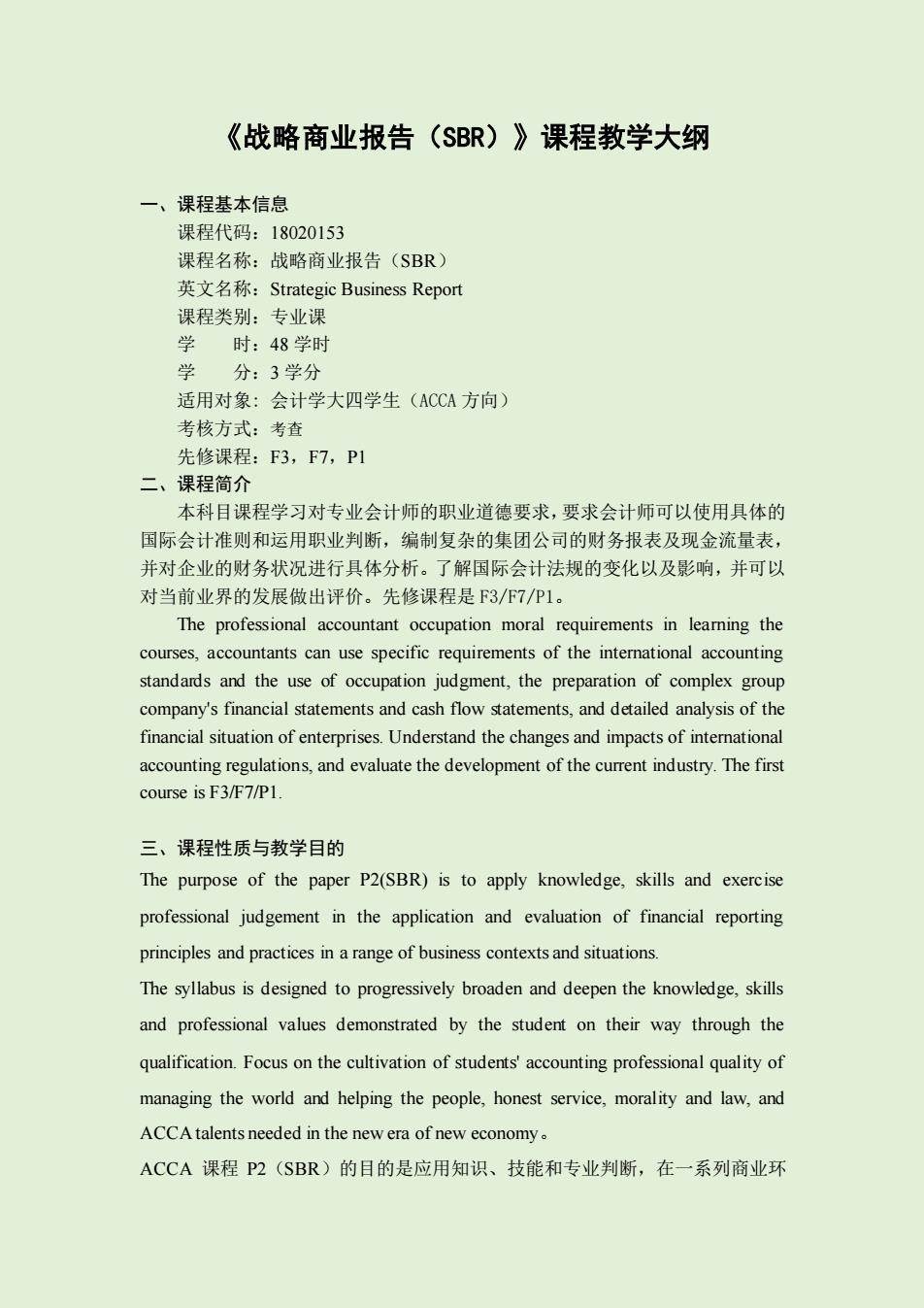
《战略商业报告(SBR)》课程教学大纲 一、课程基本信息 课程代码:18020153 课程名称:战略商业报告(SBR) 英文名称:Strategic Business Report 课程类别:专业课 学时:48学时 学分:3学分 适用对象:会计学大四学生(ACCA方向) 考核方式:考查 先修课程:F3,F7,P1 二、课程简介 本科目课程学习对专业会计师的职业道德要求,要求会计师可以使用具体的 国际会计准则和运用职业判断,编制复杂的集团公司的财务报表及现金流量表 并对企业的财务状况进行具体分析。了解国际会计法规的变化以及影响,并可以 对当前业界的发展做出评价。先修课程是F3/7/P1。 The professional accountant occupation moral requirements in learning the courses,accountants can use specific requirements of the international accounting standards and the use of occupation judgment,the preparation of complex group company's financial statements and cash flow statements.and detailed analysis of the financial situation of enterprises.Understand the changes and impacts of interational accounting regulations,and evaluate the development of the current industry.The first course is F3/F7/P1. 三、课程性质与教学目的 The purpose of the paper P2(SBR)is to apply knowledge,skills and exercise professional judgement in the application and evaluation of financial reporting principles and practices in a range of business contexts and situations. The syllabus is designed to progressively broaden and deepen the knowledge,skills and professional values demonstrated by the student on their way through the qualification.Focus on the cultivation of students accounting professional quality of managing the world and helping the people,honest service,morality and law,and ACCA talents needed in the new era of new economy. ACCA课程P2(SBR)的目的是应用知识、技能和专业判断,在一系列商业环
《战略商业报告(SBR)》课程教学大纲 一、课程基本信息 课程代码:18020153 课程名称:战略商业报告(SBR) 英文名称:Strategic Business Report 课程类别:专业课 学 时:48 学时 学 分:3 学分 适用对象: 会计学大四学生(ACCA 方向) 考核方式:考查 先修课程:F3,F7,P1 二、课程简介 本科目课程学习对专业会计师的职业道德要求,要求会计师可以使用具体的 国际会计准则和运用职业判断,编制复杂的集团公司的财务报表及现金流量表, 并对企业的财务状况进行具体分析。了解国际会计法规的变化以及影响,并可以 对当前业界的发展做出评价。先修课程是 F3/F7/P1。 The professional accountant occupation moral requirements in learning the courses, accountants can use specific requirements of the international accounting standards and the use of occupation judgment, the preparation of complex group company's financial statements and cash flow statements, and detailed analysis of the financial situation of enterprises. Understand the changes and impacts of international accounting regulations, and evaluate the development of the current industry. The first course is F3/F7/P1. 三、课程性质与教学目的 The purpose of the paper P2(SBR) is to apply knowledge, skills and exercise professional judgement in the application and evaluation of financial reporting principles and practices in a range of business contexts and situations. The syllabus is designed to progressively broaden and deepen the knowledge, skills and professional values demonstrated by the student on their way through the qualification. Focus on the cultivation of students' accounting professional quality of managing the world and helping the people, honest service, morality and law, and ACCA talents needed in the new era of new economy。 ACCA 课程 P2(SBR)的目的是应用知识、技能和专业判断,在一系列商业环

境和情况下应用和评估财务报告原则和实践。教学大纲旨在逐步拓宽和深化学生 在通过资格认证过程中所展示的知识、技能和职业价值观。 The specific capabilities within the detailed syllabuses and study guides are assessed at one of three intellectual or cognitive levels Level 1:Knowledge and comprehension Level 2:Application and analysis Level 3:Synthesis and evaluation Very broadly,these intellectual levels relate to the three cognitive levels at which the knowledge module,the skills module and the professional level are assessed. The P2 syllabus comprises eight main areas A The professional and ethical duty of the accountant B The financial reporting framework C Reporting the financial performance of entities D Financial statements of groups of entities E Specialized entities F Implications of changes in accounting regulation on financial reporting G The appraisal of financial performance and position ofentities H Current developments EXAM Exam format-comprise two sections Reading&planning time:15 minutes SectionA-one compulsory case study 50marks SectionB-choice of 2 from 3 questions 2 x 25=50 marks 100 marks Examiner:Graham Hol 四、教学内容及要求 第一章Chapter 1 Financial reporting framework (一)目的与要求Objective&requirement This chapter is partly background knowledge to set the scene about the reporting framework before you look at ethical issues,the students should
境和情况下应用和评估财务报告原则和实践。教学大纲旨在逐步拓宽和深化学生 在通过资格认证过程中所展示的知识、技能和职业价值观。 The specific capabilities within the detailed syllabuses and study guides are assessed at one of three intellectual or cognitive levels: Level 1: Knowledge and comprehension Level 2: Application and analysis Level 3: Synthesis and evaluation Very broadly, these intellectual levels relate to the three cognitive levels at which the knowledge module, the skills module and the professional level are assessed. The P2 syllabus comprises eight main areas: A The professional and ethical duty of the accountant B The financial reporting framework C Reporting the financial performance of entities D Financial statements of groups of entities E Specialized entities F Implications of changes in accounting regulation on financial reporting G The appraisal of financial performance and position of entities H Current developments EXAM Exam format – comprise two sections Reading & planning time: 15 minutes Section A – one compulsory case study 50 marks SectionB–choice of 2 from 3 questions 2 x 25 = 50 marks 100 marks Examiner: Graham Holt 四、教学内容及要求 第一章 Chapter 1 Financial reporting framework (一)目的与要求 Objective & requirement This chapter is partly background knowledge to set the scene about the reporting framework before you look at ethical issues, the students should
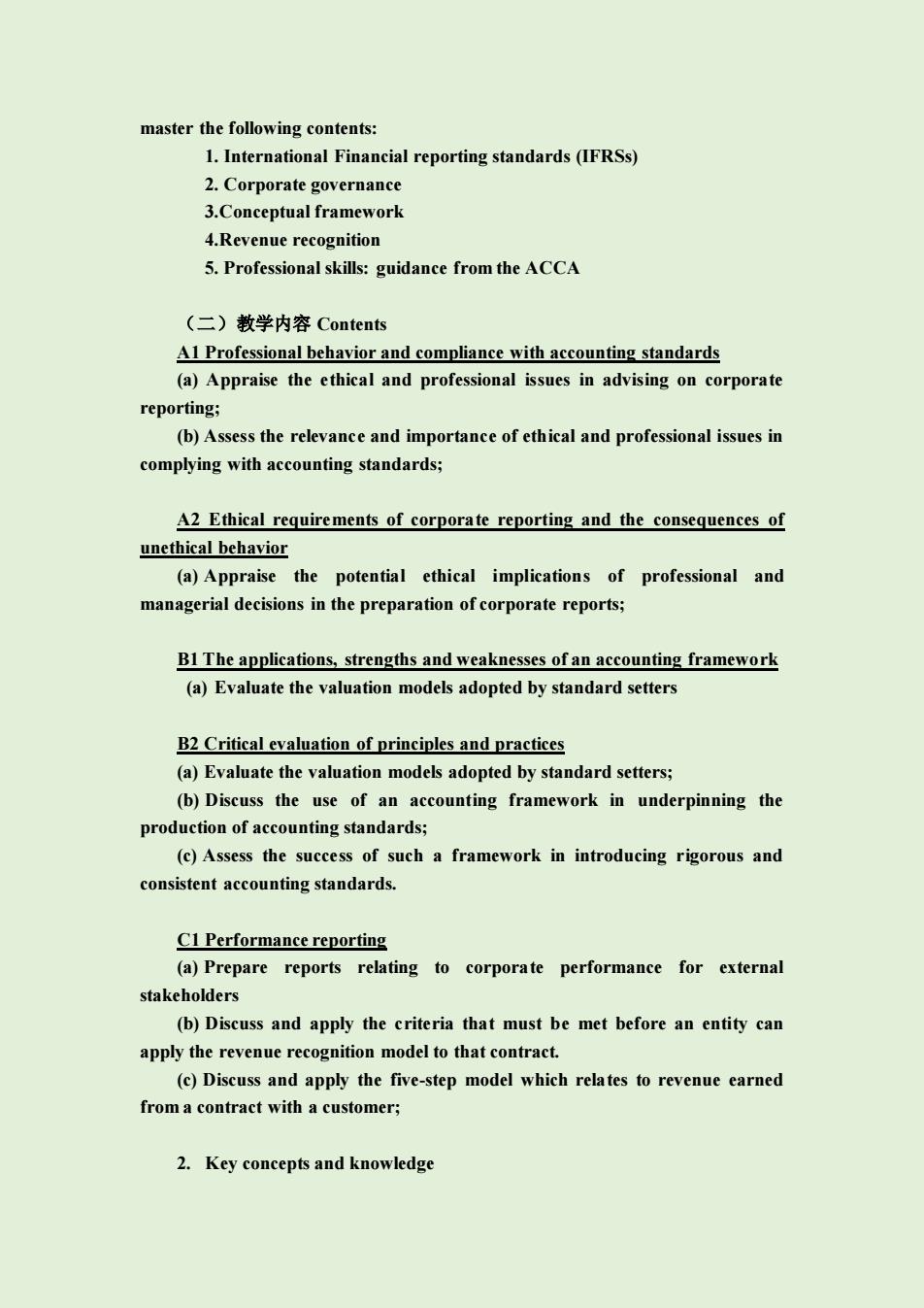
master the following contents: 1.International Financial reporting standards(IFRSs) 2.Corporate governance 3.Conceptual framework 4.Revenue recognition 5.Professional skills:guidance from the ACCA (二)教学内容Contents Al Professional behavior and compliance with accounting standards (a)Appraise the ethical and professional issues in advising on corporate reporting; (b)Assess the relevance and importance of ethical and professional issues in complying with accounting standards; A2 Ethical requirements of corporate reporting and the consequences of unethical behavior (a)Appraise the potential ethical implications of professional and managerial decisions in the preparation of corporate reports; BI The applications,strengths and weaknesses of an accounting framework (a)Evaluate the valuation models adopted by standard setters B2 Critical evaluation of principles and practices (a)Evaluate the valuation models adopted by standard setters; (b)Discuss the use of an accounting framework in underpinning the production of accounting standards; (c)Assess the success of such a framework in introducing rigorous and consistent accounting standards CI Performance reporting (a)Prepare reports relating to corporate performance for external stakeholders (b)Discuss and apply the criteria that must be met before an entity can apply the revenue recognition model to that contract. (c)Discuss and apply the five-step model which relates to revenue earned from a contract with a customer; 2.Key concepts and knowledge
master the following contents: 1. International Financial reporting standards (IFRSs) 2. Corporate governance 3.Conceptual framework 4.Revenue recognition 5. Professional skills: guidance from the ACCA (二)教学内容 Contents A1 Professional behavior and compliance with accounting standards (a) Appraise the ethical and professional issues in advising on corporate reporting; (b) Assess the relevance and importance of ethical and professional issues in complying with accounting standards; A2 Ethical requirements of corporate reporting and the consequences of unethical behavior (a) Appraise the potential ethical implications of professional and managerial decisions in the preparation of corporate reports; B1 The applications, strengths and weaknesses of an accounting framework (a) Evaluate the valuation models adopted by standard setters B2 Critical evaluation of principles and practices (a) Evaluate the valuation models adopted by standard setters; (b) Discuss the use of an accounting framework in underpinning the production of accounting standards; (c) Assess the success of such a framework in introducing rigorous and consistent accounting standards. C1 Performance reporting (a) Prepare reports relating to corporate performance for external stakeholders (b) Discuss and apply the criteria that must be met before an entity can apply the revenue recognition model to that contract. (c) Discuss and apply the five-step model which relates to revenue earned from a contract with a customer; 2. Key concepts and knowledge

Corporate governance;revenue recognition (三)思考与实践Thinking and practice 1.what is corporate governance? 2.Why is a conceptual framework necessary? 3.What are the disadvantages of a conceptual framework? 4.What are the seven sections of the IASB's framework? (四)教学方法与手段Teaching method Explain in class,and take for example,discussion 第二章Chapter2 Professional and ethical duty of accountant (一)目的与要求Objective.&requirement This chapter is about professional and ethical duty of accountant,the students should be master the following knowledge: 1.Ethical theories; 2.Influences on ethics: 3.The social and ethical environment; 4.Ethics in organizations; 5.Principles and guidance on professional ethics 6.Practical situations; 7.Examination questions:an approach (二)教学内容Contents A2 Ethical requirement of corporate reporting and the consequences of unethical behavior (a)Appraise the potential ethical implications of professional and managerial decisions in the preparation of corporate reports; (b)Assess the consequences of not upholding ethical principles in the preparation of corporate reports. Key concepts A key debate in ethical theory is whether ethics can be determined by objective,universal principles,How important the consequences of actions should be in determining an ethical position is also a significant issue. Accountants require an ethical code because they hold positions of trust and people rely on them IFAC's and ACCA'sguidance is very similar
Corporate governance; revenue recognition; (三)思考与实践 Thinking and practice 1. what is corporate governance? 2. Why is a conceptual framework necessary? 3. What are the disadvantages of a conceptual framework? 4. What are the seven sections of the IASB’s framework? (四) 教学方法与手段 Teaching method Explain in class, and take for example, discussion 第二章 Chapter 2 Professional and ethical duty of accountant (一) 目的与要求 Objective & requirement This chapter is about professional and ethical duty of accountant, the students should be master the following knowledge: 1. Ethical theories; 2. Influences on ethics; 3. The social and ethical environment; 4. Ethics in organizations; 5. Principles and guidance on professional ethics; 6. Practical situations; 7. Examination questions: an approach. (二)教学内容 Contents A2 Ethical requirement of corporate reporting and the consequences of unethical behavior (a) Appraise the potential ethical implications of professional and managerial decisions in the preparation of corporate reports; (b) Assess the consequences of not upholding ethical principles in the preparation of corporate reports. Key concepts A key debate in ethical theory is whether ethics can be determined by objective, universal principles, How important the consequences of actions should be in determining an ethical position is also a significant issue. Accountants require an ethical code because they hold positions of trust, and people rely on them IFAC’s and ACCA’s guidance is very similar
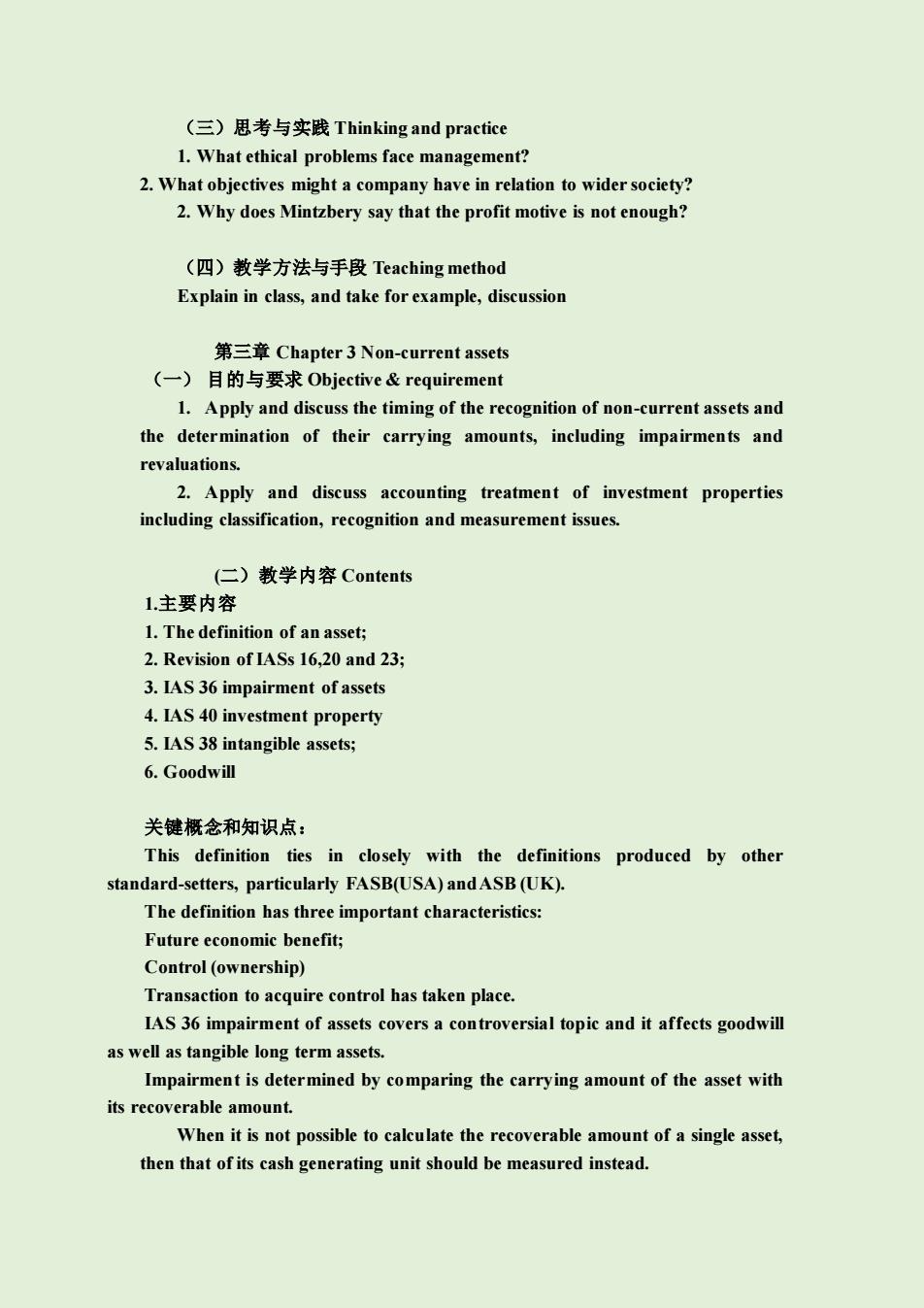
(三)思考与实践Thinking and practice 1.What ethical problems face management? 2.What objectives might a company have in relation to wider society? 2.Why does Mintzbery say that the profit motive is not enough? (四)教学方法与手段Teaching method Explain in class,and take for example,discussion 第三章Chapter3Non-current assets (一)目的与要求Objective&requirement 1.Apply and discuss the timing of the recognition of non-current assets and the determination of their carrying amounts,including impairments and revaluations. 2.Apply and discuss accounting treatment of investment properties including classification,recognition and measurement issues. (二)教学内容Contents 1.主要内容 1.The definition of an asset; 2.Revision of IASs 16,20 and 23; 3.IAS36 impairment of assets 4.IAS 40 investment property 5.IAS 38 intangible assets; 6.Goodwill 关键概念和知识点: This definition ties in closely with the definitions produced by other standard-setters,particularly FASB(USA)andASB(UK). The definition has three important characteristics: Future economic benefit; Control (ownership) Transaction to acquire control has taken place. IAS 36 impairment of assets covers a controversial topic and it affects goodwill as well as tangible long term assets. Impairment is determined by comparing the carrying amount of the asset with its recoverable amount. When it is not possible to calculate the recoverable amount of a single asset, then that of its cash generating unit should be measured instead
(三)思考与实践 Thinking and practice 1. What ethical problems face management? 2. What objectives might a company have in relation to wider society? 2. Why does Mintzbery say that the profit motive is not enough? (四)教学方法与手段 Teaching method Explain in class, and take for example, discussion 第三章 Chapter 3 Non-current assets (一) 目的与要求 Objective & requirement 1. Apply and discuss the timing of the recognition of non-current assets and the determination of their carrying amounts, including impairments and revaluations. 2. Apply and discuss accounting treatment of investment properties including classification, recognition and measurement issues. (二)教学内容 Contents 1.主要内容 1. The definition of an asset; 2. Revision of IASs 16,20 and 23; 3. IAS 36 impairment of assets 4. IAS 40 investment property 5. IAS 38 intangible assets; 6. Goodwill 关键概念和知识点: This definition ties in closely with the definitions produced by other standard-setters, particularly FASB(USA) and ASB (UK). The definition has three important characteristics: Future economic benefit; Control (ownership) Transaction to acquire control has taken place. IAS 36 impairment of assets covers a controversial topic and it affects goodwill as well as tangible long term assets. Impairment is determined by comparing the carrying amount of the asset with its recoverable amount. When it is not possible to calculate the recoverable amount of a single asset, then that of its cash generating unit should be measured instead

IAS 40 investment property defines investment property as property held to earn rentals or for capital appreciation or both,rather than for: -Use in production orsupply of goods or services; -Sale in the ordinary course of business. (三)思考与实践Thinking and practice 1.How does the IASB Framework define as asset? 2.How might a non-current asset be defined? 3.Define an impairment, 4.How is value in use calculated? (四)教学方法与手段Teaching methods Explain in class,and take for example,discussion 第四章Chapter4 Employee benefits (一)目的与要求Objective&requirement 1.Apply and discuss the accounting treatment of short term and long term employee benefits and defined contribution and defined benefit plans. 2.Identify the issues and deficiencies which have led to a proposed change to an accounting standard. (二)教学内容Contents 主要内容 1.IAS 19 Employee benefits; 2.Short-term employee benefi 3.Post-employment benefits 4.Defined contribution plans 5.Defined benefit plans:recognition and measurement; 6.Defined benefit plans:other matters; 7.Other long-term benefits: 8.Disclosures 关键概念与知识点: Employee benefits: 1.Account for gains and losses on settlements and curtailments; 2.Account for the "asset ceiling test"and the reporting of actuarial gains and losses; Proposed changes to accounting standards Identify the issues and deficiencies which have led to a proposed change to an accounting standard
IAS 40 investment property defines investment property as property held to earn rentals or for capital appreciation or both, rather than for: —Use in production or supply of goods or services; —Sale in the ordinary course of business. (三)思考与实践 Thinking and practice 1. How does the IASB Framework define as asset? 2. How might a non-current asset be defined? 3. Define an impairment, 4. How is value in use calculated? (四)教学方法与手段 Teaching methods Explain in class, and take for example, discussion 第四章 Chapter 4 Employee benefits (一) 目的与要求 Objective & requirement 1. Apply and discuss the accounting treatment of short term and long term employee benefits and defined contribution and defined benefit plans. 2. Identify the issues and deficiencies which have led to a proposed change to an accounting standard. (二)教学内容 Contents 主要内容 1. IAS 19 Employee benefits; 2. Short-term employee benefit 3. Post-employment benefits 4. Defined contribution plans 5. Defined benefit plans: recognition and measurement; 6. Defined benefit plans: other matters; 7. Other long-term benefits; 8. Disclosures 关键概念与知识点: Employee benefits: 1. Account for gains and losses on settlements and curtailments; 2. Account for the “asset ceiling test” and the reporting of actuarial gains and losses; Proposed changes to accounting standards Identify the issues and deficiencies which have led to a proposed change to an accounting standard

(三)思考与实践Thinking and practice 1.what are the four categories of employee benefits given by IAS 19? 2.What is the difference between defined contribution and defince benefit plans? 3.What is a "constructive obligation"compared to a legal obligation (四)教学方法与手段Teaching methods Explain in class,and take for example,discussion 第五章Chapter5 Provisions,,contingencies and events after the reporting period (一)目的与要求Objective&requirement 1.Apply and discuss the recognition,derecognition and measurement of provisions,contingent liabilities and contingent assets,including environmental provisions. 2.Calculate and discuss restructuring provisions; 3.Apply and discuss accounting for events after the reporting date; 4.Determine going concern issues arising after the reporting date. (仁)教学内容Contents 主要内容: 1.Revision of IAS 10 events after the reporting period 2.IAS 37 provisions,contingent liabilities and contingent assets 3.Proposed amendments. 关键概念与知识点: 1.IAS 10 should be familiar from your earlier studies,but it still could come up in part of a question 2.Under IAS37,a provisions should be recognized: (1)when an entity has a present obligation,legal or constructive; (2)It is probable that a transfer of economic benefits will be required to settle it; (3)A reliable estimate can be made of its amount. (三)思考与实践Thinking and practice 1.According to IAS 37 when,and only when,can a provision be recognized? 2.A provision can be made for future operating losses,true of false? 3.When should a contingent liability be recognized? (四)教学方法与手段Teaching methods
(三)思考与实践 Thinking and practice 1. what are the four categories of employee benefits given by IAS 19? 2. What is the difference between defined contribution and defince benefit plans? 3. What is a “constructive obligation” compared to a legal obligation? (四)教学方法与手段 Teaching methods Explain in class, and take for example, discussion 第五 章 Chapter 5 Provisions, contingencies and events after the reporting period (一) 目的与要求 Objective & requirement 1. Apply and discuss the recognition, derecognition and measurement of provisions, contingent liabilities and contingent assets, including environmental provisions. 2. Calculate and discuss restructuring provisions; 3.Apply and discuss accounting for events after the reporting date; 4.Determine going concern issues arising after the reporting date. (二)教学内容 Contents 主要内容: 1. Revision of IAS 10 events after the reporting period 2. IAS 37 provisions, contingent liabilities and contingent assets; 3. Proposed amendments. 关键概念与知识点: 1. IAS 10 should be familiar from your earlier studies, but it still could come up in part of a question, 2.Under IAS 37,a provisions should be recognized: (1)when an entity has a present obligation, legal or constructive; (2)It is probable that a transfer of economic benefits will be required to settle it; (3)A reliable estimate can be made of its amount. (三)思考与实践 Thinking and practice 1. According to IAS 37 when, and only when, can a provision be recognized? 2. A provision can be made for future operating losses, true of false? 3. When should a contingent liability be recognized? (四)教学方法与手段 Teaching methods
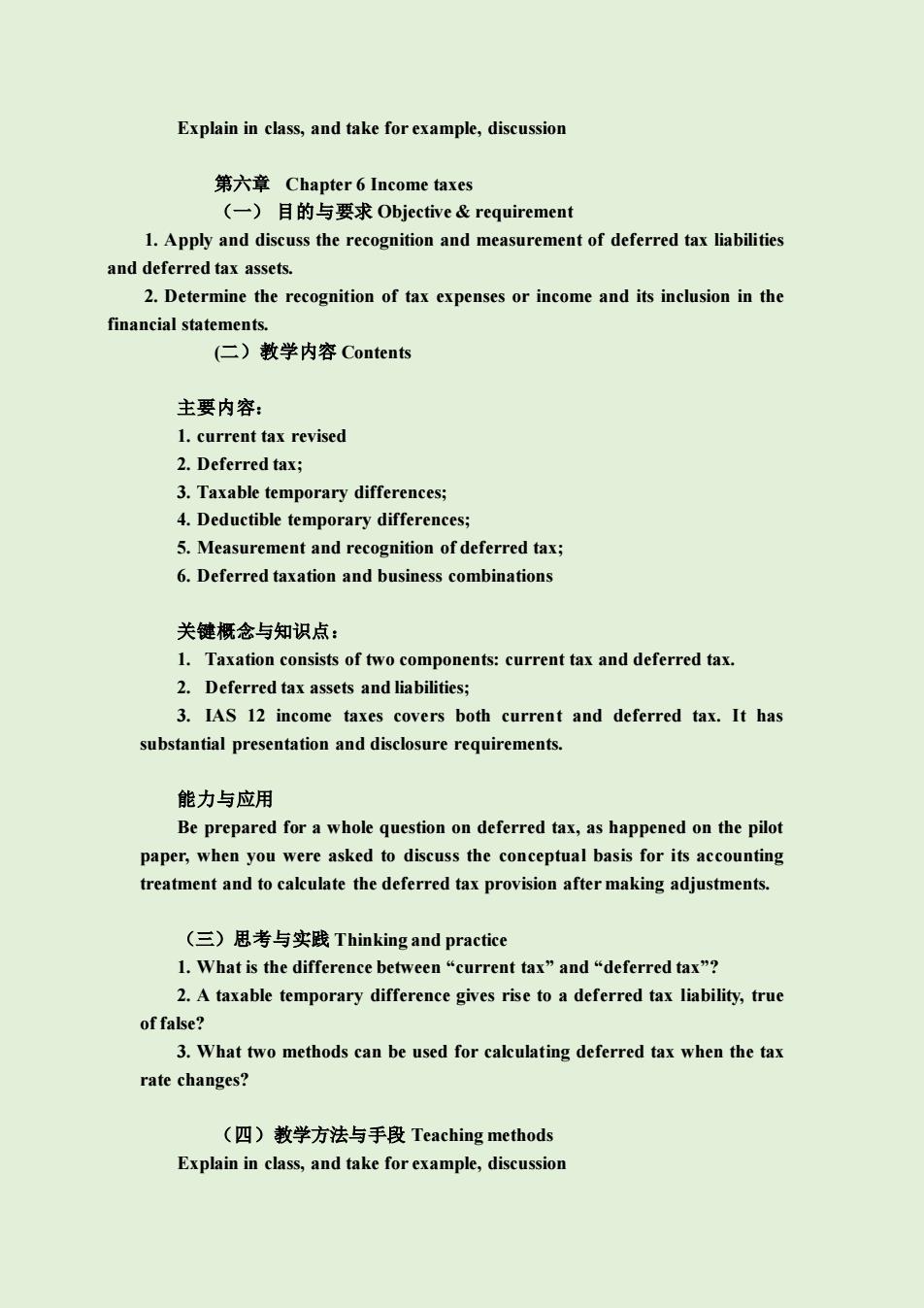
Explain in class,and take for example,discussion 第六章Chapter6 Income taxes (一)目的与要求Objective&requirement 1.Apply and discuss the recognition and measurement of deferred tax liabilities and deferred tax assets. 2.Determine the recognition of tax expenses or income and its inclusion in the financial statements. (二)教学内容Contents 主要内容: 1.current tax revised 2.Deferred tax; 3.Taxable temporary differences; 4.Deductible temporary differences; 5.Measurement and recognition of deferred tax; 6.Deferred taxation and business combinations 关键概念与知识点: 1.Taxation consists of two components:current tax and deferred tax 2.Deferred tax assets and liabilities; 3.IAS 12 income taxes covers both current and deferred tax.It has substantial presentation and disclosure requirements. 能力与应用 Be prepared for a whole question on deferred tax,as happened on the pilot paper,when you were asked to discuss the conceptual basis for its accounting treatment and to calculate the deferred tax provision after making adjustments (三)思考与实践Thinking and practice l.What is the difference between“current tax'”and“deferred tax"? 2.A taxable temporary difference gives rise to a deferred tax liability,true of false? 3.What two methods can be used for calculating deferred tax when the tax rate changes? (四)教学方法与手段Teaching methods Explain in class,and take for example,discussion
Explain in class, and take for example, discussion 第六章 Chapter 6 Income taxes (一) 目的与要求 Objective & requirement 1. Apply and discuss the recognition and measurement of deferred tax liabilities and deferred tax assets. 2. Determine the recognition of tax expenses or income and its inclusion in the financial statements. (二)教学内容 Contents 主要内容: 1. current tax revised 2. Deferred tax; 3. Taxable temporary differences; 4. Deductible temporary differences; 5. Measurement and recognition of deferred tax; 6. Deferred taxation and business combinations 关键概念与知识点: 1. Taxation consists of two components: current tax and deferred tax. 2. Deferred tax assets and liabilities; 3. IAS 12 income taxes covers both current and deferred tax. It has substantial presentation and disclosure requirements. 能力与应用 Be prepared for a whole question on deferred tax, as happened on the pilot paper, when you were asked to discuss the conceptual basis for its accounting treatment and to calculate the deferred tax provision after making adjustments. (三)思考与实践 Thinking and practice 1. What is the difference between “current tax” and “deferred tax”? 2. A taxable temporary difference gives rise to a deferred tax liability, true of false? 3. What two methods can be used for calculating deferred tax when the tax rate changes? (四)教学方法与手段 Teaching methods Explain in class, and take for example, discussion
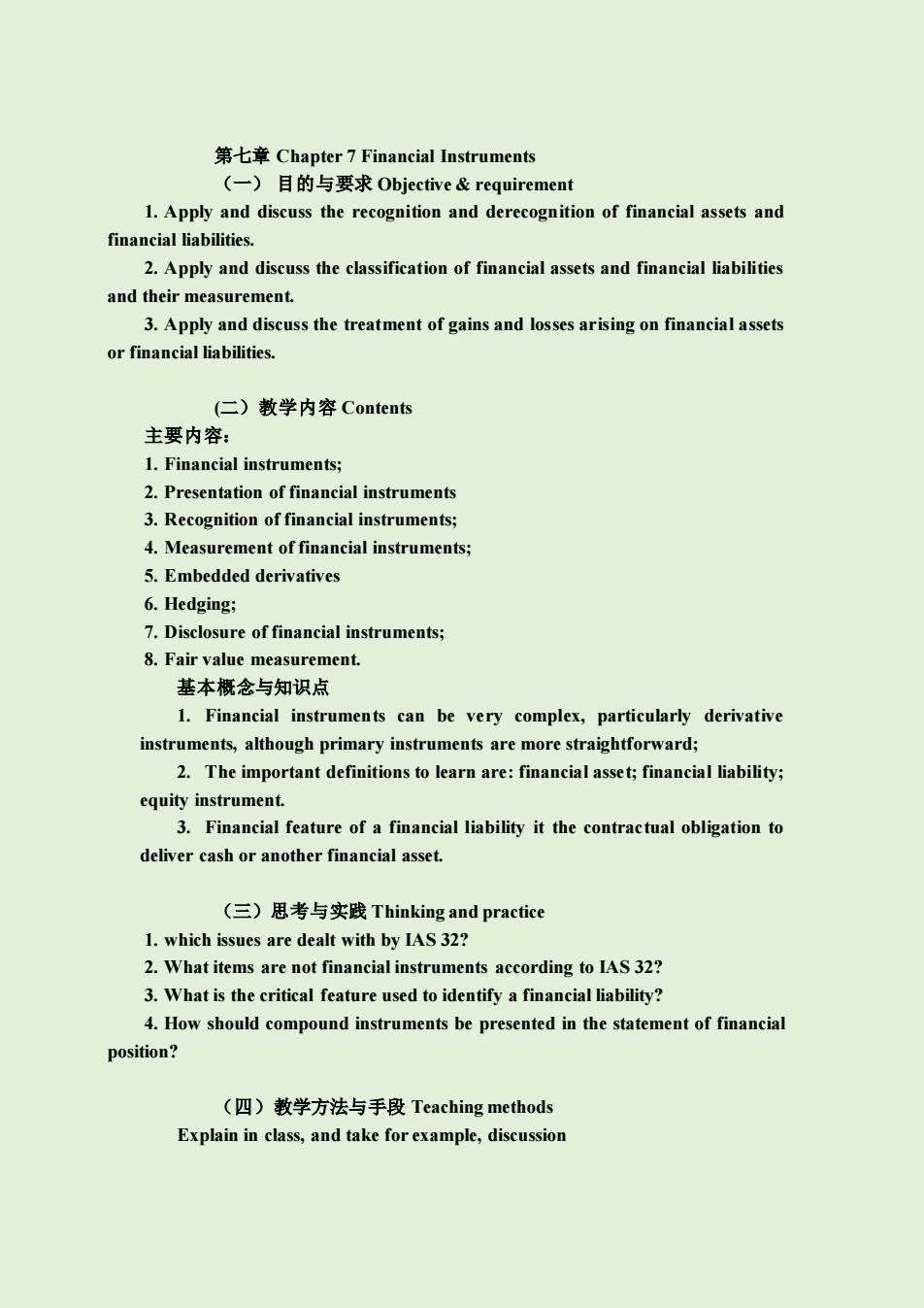
第七章Chapter7 Financial Instruments (一)目的与要求Objeetive&requirement 1.Apply and discuss the recognition and derecognition of financial assets and financial liabilities 2.Apply and discuss the classification of financial assets and financial liabilities and their measurement 3.Apply and discuss the treatment of gains and losses arising on financial assets or financial liabilities (仁)教学内容Contents 主要内容: 1.Financial instruments; 2.Presentation of financial instruments 3.Recognition of financial instruments; 4.Measurement of financial instruments; 5.Embedded derivatives 6.Hedging; 7.Disclosure of financial instruments; 8.Fair value measurement. 基本概念与知识点 1.Financial instruments can be very complex,particularly derivative instruments,although primary instruments are more straightforward; 2.The important definitions to learn are:financial asset;financial liability; equity instrument. 3.Financial feature of a financial liability it the contractual obligation to deliver cash or another financial asset. (三)思考与实践Thinking and practice 1.which issues are dealt with by IAS 32? 2.What items are not financial instruments according to IAS 32? 3.What is the critical feature used to identify a financial liability? 4.How should compound instruments be presented in the statement of financial position? (四)教学方法与手段Teaching methods Explain in class.and take for example.discussion
第七章 Chapter 7 Financial Instruments (一) 目的与要求 Objective & requirement 1. Apply and discuss the recognition and derecognition of financial assets and financial liabilities. 2. Apply and discuss the classification of financial assets and financial liabilities and their measurement. 3. Apply and discuss the treatment of gains and losses arising on financial assets or financial liabilities. (二)教学内容 Contents 主要内容: 1. Financial instruments; 2. Presentation of financial instruments 3. Recognition of financial instruments; 4. Measurement of financial instruments; 5. Embedded derivatives 6. Hedging; 7. Disclosure of financial instruments; 8. Fair value measurement. 基本概念与知识点 1. Financial instruments can be very complex, particularly derivative instruments, although primary instruments are more straightforward; 2. The important definitions to learn are: financial asset; financial liability; equity instrument. 3. Financial feature of a financial liability it the contractual obligation to deliver cash or another financial asset. (三)思考与实践 Thinking and practice 1. which issues are dealt with by IAS 32? 2. What items are not financial instruments according to IAS 32? 3. What is the critical feature used to identify a financial liability? 4. How should compound instruments be presented in the statement of financial position? (四)教学方法与手段 Teaching methods Explain in class, and take for example, discussion

第八章Chapter8 leases (一)目的与要求Objective&requirement 1.Apply and discuss the classification of leases and accounting by lessors and lessees. 2.Account for and discuss sale and leaseback transactions (二)教学内容Contents 1.Forms of lease 2 lessee accounting 3.lessor accounting 4.criticism and proposed changes 基本概念与知识点: 1.IAS 17 covers the accounting under lease transactions for both lessees and lessors. 2.There are two forms of lease:finance leases and operating leases. 3.The definition of a finance lease is very important:it is a lease that transfers all the risks and rewards of ownership of the asset,regardless of whether legal title passes. 4.Lessee accountig 5.Lessor accounting. (三)思考与实践Thinking and practice 1.Distinguish between a finance lease and an operating lease. 2.List the disclosure requirement for lessees under finance leases. 3.What are the arguments both for and against lessees capitalizing leased assets? (四)教学方法与手段Teaching methods Explain in class,and take for example,discussion 第九章Chapter9 Share-based payment (一)目的与要求Objective&requirement 1.Apply and discuss the recognition and measurement criteria for share-based payment transactions; 2.Account for modifications,cancellations and settlements of share-based payment transactions. (二)教学内容Contents 主要内容:
第八章 Chapter 8 leases (一) 目的与要求 Objective & requirement 1. Apply and discuss the classification of leases and accounting by lessors and lessees. 2. Account for and discuss sale and leaseback transactions. (二)教学内容 Contents 1.Forms of lease 2 lessee accounting 3.lessor accounting 4.criticism and proposed changes. 基本概念与知识点: 1. IAS 17 covers the accounting under lease transactions for both lessees and lessors. 2. There are two forms of lease: finance leases and operating leases. 3. The definition of a finance lease is very important: it is a lease that transfers all the risks and rewards of ownership of the asset, regardless of whether legal title passes. 4. Lessee accounting; 5. Lessor accounting. (三)思考与实践 Thinking and practice 1. Distinguish between a finance lease and an operating lease. 2. List the disclosure requirement for lessees under finance leases. 3. What are the arguments both for and against lessees capitalizing leased assets? (四)教学方法与手段 Teaching methods Explain in class, and take for example, discussion 第九章 Chapter 9 Share-based payment (一) 目的与要求 Objective & requirement 1. Apply and discuss the recognition and measurement criteria for share-based payment transactions; 2. Account for modifications, cancellations and settlements of share-based payment transactions. (二)教学内容 Contents 主要内容: